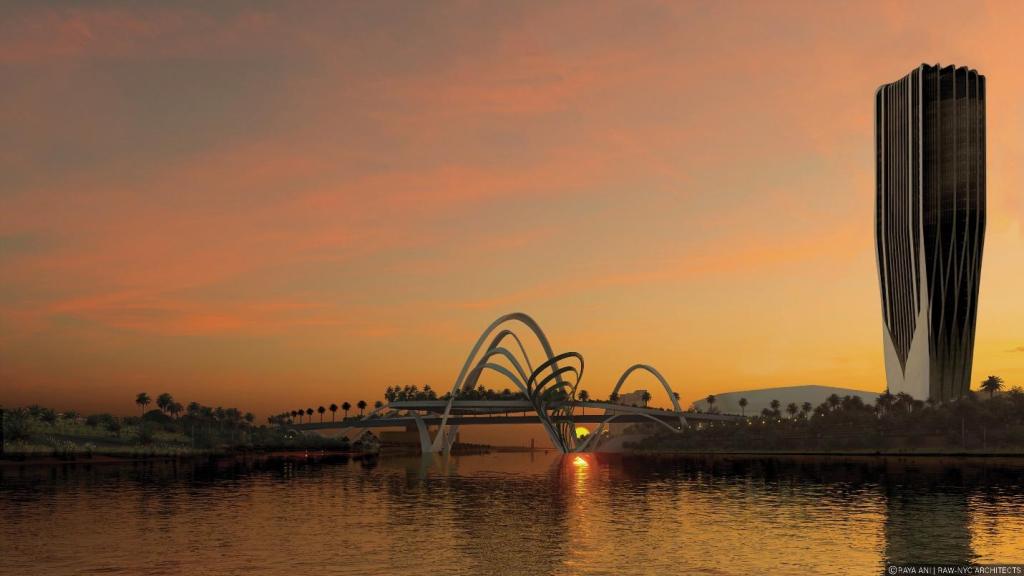At RAW-NYC Architects, we are committed to architecture and urban design while incorporating three guiding principles – Innovation, Sustainability, and Technology. Working with these principles, our recent project expanded on the concept of a public bridge, by creating more than a car/ pedestrian bridge that gets you from one side to another, but rather an urban public space experience. It complements the Central Bank of Iraq building by Zaha Hadid Architects, adding to the Baghdad cityscape along the historic Tigris River. The Green Bridge of Baghdad project forms a floating urban park whose six zones highlight the achievements of ancient Mesopotamia which forms present-day Iraq.
The earliest known region to have a developed bureaucracy, monumental architecture, and advanced science and technology, ancient Mesopotamian ideas prevail in the fields of literacy, law, math, astronomy, and the gift of civilization itself. The impact of their scholarly legacy on the modern day has been profound. With the mighty Tigris running across it, the “Green Bridge of Baghdad” explores and illuminates more than 3000 years of ancient legacy.
The Pedestrian Bridge is inspired from the heart – the universal logo of love and the seat of deepest emotions. Divided into six zones, each celebrating a unique aspect of Mesopotamian achievements, the pedestrian bridge forms a floating urban park that functions as a retreat and transforms the cityscape of Baghdad for its citizens.
The Mulapin zone celebrates the achievements of Mesopotamian astronomers in discovering planets and tracking their course.
The IM 67118 zone – inspired by the name of a cuneiform tablet – honors the contribution of Mesopotamians in mathematics, having devised the number system and highly developed principles of geometry.
Their sexagesimal or the Base 60 number system gave rise to the way we conceive modern-day time. The 12-60 zone forms a changing exhibit inspired by this concept.
The Mesopotamians were the first ones to develop the written language – the Cuneiform script. The writing zone is named after the Cuneiform Seals which they used in their administrative work.
The Gilgamesh Theatre celebrates the rich legacy of literature from the Mesopotamian era. The earliest poems – Epic of Gilgamesh – and authors – Enheduanna – belonged to the region of Mesopotamia. The zone is conceived as a performance space to bring more visibility to the poets and the literary works.
The Art Space forms a space for community engagement. Inspired by the relief artwork of Ancient Mesopotamia, the mosaic wall comprises tablets where people can paint their artwork and display it on the walls, The space also incorporates commissioned artwork, bringing visibility to local artists and encouraging collaborations with international artists.
Mesopotamian achievements went further than the ones represented in the six zones of the park. For example, the Farming Path is designed as an urban farm for the community to learn about agricultural methods along with fruit trees, from which the Iraqis can pluck and eat native fruits. Furthermore, the Scent Path, planted with fragrant flowering bushes, acknowledges the first-ever advance towards the field of chemistry by a Babylonian noblewoman, through perfume-making.
The Green Bridge of Baghdad, nicknamed the “Heart of Baghdad” embraces innovation and sustainability at its core. With water filters recycling Tigris River water for irrigation and heterotrophic algae working as an air purifier, the bridge forms an ecosystem of its own, for the community.
The Green Bridge of Baghdad forms an iconic symbol that would articulate the idea of Baghdad for today and tomorrow – to show Iraq’s magnificent history to the world and the nation. The Heart of Baghdad would resonate with, and inspire the masses; it is a quest to create a landmark that will never cease in its intent to amaze.
Combined with other visionary and sustainable projects such as the Iraq Pavilion, the Marshes of Southern Iraq, the Creek Mosque, and the Guggenheim Museum, is why RAW-NYC is considered one of the Top Architecture Firms in Dubai and the top Urban Design Firms in Dubai.
For more information please visit: — https://www.rayaani.com/
